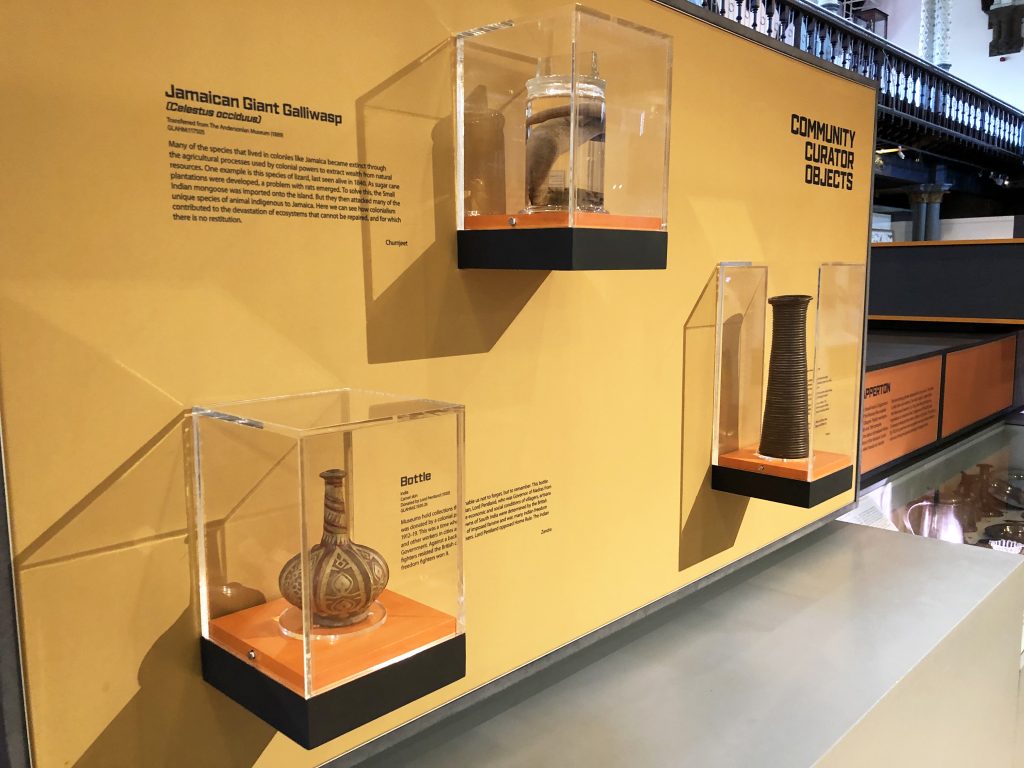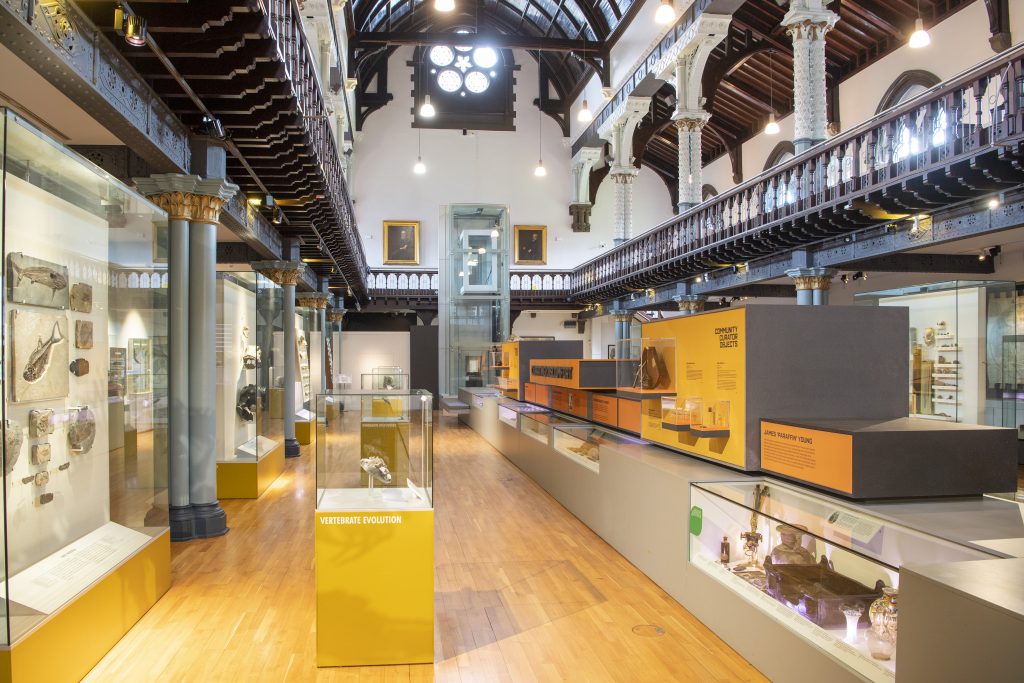Enjoy this article?
Most Museums Journal content is only available to members. Join the MA to get full access to the latest thinking and trends from across the sector, case studies and best practice advice.
I first visited the Hunterian at the University of Glasgow, Scotland’s oldest museum, as a teenager, in the 1990s. I remember standing at the threshold of the great hall, falling in love with the place, but feeling intimidated by the breathtaking exterior, the history surrounding the place and the objects. I vividly remember not feeling very welcome in the space, going by some of the looks I got as I walked around.
Before my visit this time, I had been advised that Curating Discomfort was an intervention in the museum’s collection that looks at ways outside traditional museum authority to explore the interpretation of contested collections in order to take the museum out of the institutional comfort zone. There is now widespread recognition that racism – institutional, social or otherwise – is a problem in Scotland, as in other places.
A University of Glasgow report on its historical links with slavery acknowledges that while it played a leading role in the abolitionist movement, the institution also received significant financial support from people whose wealth derived, at least in part, from slavery.
This time around, I was welcomed by a lovely front of house staff member who asked me if I had visited before and told me with a smile to enjoy the visit.
The Curating Discomfort intervention, designed with an eye-catching bright orange, is the central display in the main hall, while the wall immediately to the right describes the ideas behind the project.
I particularly liked the descriptions of the staff workshops as well as the visually easy-to-read board, which covers a lot of complex concepts in an accessible and meaningful way. The Hunterian invited six people – activists, social justice campaigners and educators – to form a community curators group that contributed expertise and knowledge and identified and wrote labels for some of the objects on display.
These include, for example, a camelskin water bottle from India, donated by Lord Pentland, governor of Madras from 1912 to 1919 – a time when the economic and social conditions of villagers, artisans and other workers in cities and towns of South India were determined by the British government.

Also from India is a miniature, painted on a mica plate, of a turbaned and moustached merchant in bright yellow trousers selling spices and herbs in a market. The object label explains that before British rule, such paintings drew on Indian folklore and religious scriptures and illustrated accompanying texts.
With the change in patronage from regional monarchs to East India Company officials, artists who created miniatures focused on western techniques, paying attention to texture, colour and photographic accuracy, and documenting Indian life and types. One cabinet contains minerals from the collection of Dr Thomas Brown of Lanfine, a well-known doctor in early 19th-century Glasgow, whose family made its wealth from banking. Among the stones and crystals is a patu onewa, a Maori sharp-edged stone club. The label asks who these items belong to – was this lost by a warrior? Was it traded or looted? What would it mean to the Maori people if it was returned?
There are many good things about this project: it has led to extensive research and collaborations, facilitated dialogue and given a safe space for conversations that were not possible before.
The project has allowed a new approach to interpretation and display and acknowledges issues that have long haunted the museum world.
The family friendly space the museum has created offers engaging activities for children and on one side of the hall is a clearly labelled calm space – a welcome extra for people with additional needs. The lighting is also calming and, together with the space’s natural light, creates a relaxing atmosphere that gave me space to reflect.
The themes of anti-racism and decolonisation are prevalent throughout Curating Discomfort. The exhibition has broad appeal via the podcasts on the Hunterian’s website, online materials and blogs. But for me, the highlight is the way the labels are written: honestly and presenting history as it really was.
The team at the Hunterian has done a wonderful job at starting the conversation in the museum sector, and this intervention links well with other steps the university is taking towards reparative justice. People such as Zandra Yeaman, the Hunterian’s curator of discomfort, are doing amazing work facilitating uncomfortable conversations and educating people about anti-racism. Having experienced bullying and racism in this country, professionally and personally, I welcome this intervention: these conversations would not have been possible 20 years ago.
The sad truth is, however, that visiting a university and an academic museum is not something everyone thinks they can do – there are still many sections of society who will find coming through these doors intimidating.
While university museums have a remit to use their collections for education and teaching, if these spaces are occupied by the wealthy and privileged then how are ordinary people benefiting from these amazing collections?
How are they learning about their heritage or history? If the museum staff are like gatekeepers, or if the people who occupy these spaces make others feel as though they are not educated enough to be there, a lot of work needs to be done.

I applaud the Hunterian for doing this work. It takes courage and heart to admit wrong and create change around a subject so sensitive for so many.
The wrongs of the past cannot be put right overnight. For some, entering this space and looking at these objects will reopen wounds and bring back long-suppressed pain; for others, seeing these objects and knowing these conversations are taking place will bring peace and healing.
It is some comfort that times are changing. But while this is to be celebrated, how does this translate into practice?
The Hunterian’s strategic plan for 2021-25 has raised some key issues, including collections strategy, audience development, people and resources, which will make a huge difference in the coming years. But most senior positions are still occupied, and decision-making power is held, by privileged white people, male and female.
Among the questions that need to be asked are: has the Hunterian hired more people of colour as staff in all roles? Are there any programmes and initiatives in place for first gen (the first in their families to have higher education) and aspiring curators who are people of colour?
How has the university and museum dealt with workplace bullying and discrimination? Are whistle-blowing procedures in place? Are the Hunterian Friends actively encouraging the community, including those who are marginalised, to access these spaces, and what initiatives are taking place in audience development? What is being done to make these people feel welcome?
Real change comes from practical, tangible steps. These might include digital interactives displaying curator talks on objects in different languages; a more representative group of staff who are visible in
the museum; and better advertising off campus for exhibitions like this.
Yeaman and the team at the Hunterian are doing much-needed work that is creating lasting change, as well as a space for dialogue that is welcome and necessary for the museum sector to evolve. I look forward to the future of the changing Hunterian.
Most Museums Journal content is only available to members. Join the MA to get full access to the latest thinking and trends from across the sector, case studies and best practice advice.